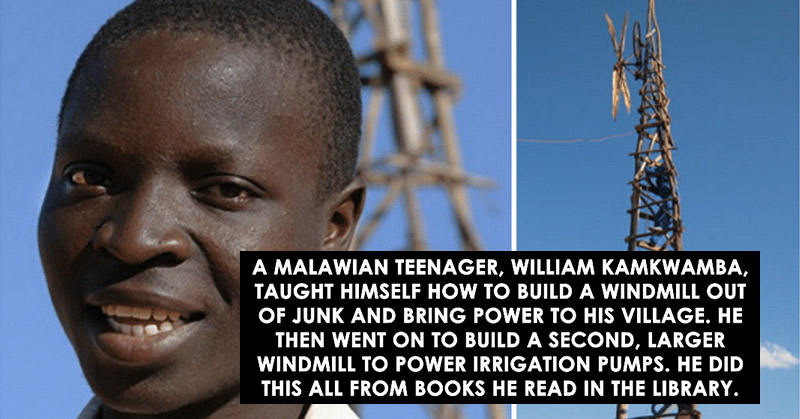Many people think about changing the world, making a difference, or becoming something more, but few have the courage to act on that impulse. Stories of innovation and success inspire us and should be shared, and none are as inspirational as the actions of a Malawian teenager who taught himself how to build a windmill and brought power to his village.
William Kamkwamba was 14 when he struck with poverty and famine; today, he is an influential inventor and speaker.
Dropping Out of School Didn’t Stop Him
Kamkwamba was born on August 5, 1987, in Dowa, Malawi. His childhood was spent on his family’s farm in Masitala Village, Wimbe, about two hours from Malawi’s capital city. Kamkwamba was the second eldest child among six sisters, Annie, Dorris, Rose, Aisha, Mayless, and Tiyamike.
Kamkwamba studied at the Wimbe Primary School from first to eighth grade and was accepted to the Kachokolo Secondary School. However, a severe famine in 2002 forced him to drop out of school when his family was unable to pay the $80 annual school fee. He had completed only a few months of his freshman year and was unable to return for the next five years.
Still, Kamkwamba wouldn’t be defeated by his unfortunate circumstances. At 14, he began borrowing books from a small community lending library at his former primary school. There he found the book that would change the course of his life.
It was an 8th grade American textbook called Using Energy and it had wind turbines on its front cover. It inspired his idea to create a windmill to power his family’s home. Until that point, the house used kerosene for power, which resulted in weak, smoky, and expensive light after nightfall.
The Windmills Were Just the Beginning
The teenager went to work. First, he built a prototype of his invention with a radio motor. Then he constructed his first 5-meter windmill out of a broken bike, tractor fan blade, an old shock absorber, and blue gum trees. He hooked the windmill to a car battery for storage, and his invention was complete. He successfully powered four light bulbs and charge mobile phones for his neighbors. His windmill even had a light switch and circuit breaker created from nails, wire, and magnets.
Later on, he expanded this windmill to 12 meters to catch more wind and create more power. Then he built another windmill to pump water for an irrigation system.
The young inventor was just getting started. His next projects provided clean water for the village, malaria prevention, solar power and lighting for six households, a deep well with a solar-powered pump to create clean water, a drip irrigation system, and uniforms and shoes for the Wimbe United village team. Quite appropriately, the uniforms are sun and wind-themed and took the team on a winning streak that filled the village with unity and pride.
Word spread about the wonderful windmill, catching the attention of Dr. Hartford Mchazime, Ph.D., the deputy director of the MTTA, the Malawian NGO responsible for the community library that inspired the young inventor in the first place.
Mchazime brought the press, including the Malawi Times, who wrote a long cover story about Kamkwamba. Soyapi Mumba and Mike McKay, engineers at Baobab Health Partnership in Malawi wrote about the article, and news of Kamkwamba’s inventions spread to Emeka Okafor, the program director for TEDGlobal. Okafor searched quite diligently to find Kamkwamba and invite him to the conference as a speaker. Kamkwamba’s talk led to additional mentors, donors, and companies to support his education and further projects.
In 2014, Kamkwamba graduated from Dartmouth College and began to work at Ideo.org as a Global Fellow. There he focused on Human Centered Design, which sent him on missions around the world including sanitation projects in India and preventing gender-based violence in Kenya.
Today, he works with WiderNet to create a technology curriculum that will allow students to make the connection between “knowing” and “doing,” as he did at their age. This content will be distributed around Malawi and across the continent. [1]
Internet Famous
A meme circulated the world wide web in August 2016, sharing the story of William Kamkwamba. It read:
“A Malawian teenager, William Kamkwamba, taught himself how to build a windmill out of junk and bring power to his village. He then went on to build a second, larger windmill to power irrigation pumps. He did this all from books he read in the library.”
At the top of the picture read: “Share this. Let’s make him famous because the media won’t.”
Fortunately for everyone, that last sentence is not true.
Kamkwamba’s story has been shared from the Wall Street Journal to Time to the Daily Show with Jon Stewart. He’s spoken at a TED conference in 2007. His inspiring tale has been documented in an autobiography co-written with Bryan Mealer, The Boy Who Harnessed the Wind, which was published in 2009, and inspired a Netflix film under that same name, released in January 2019.
It’s safe to say he’s now famous, and deservedly so. We need more heroes like him, and his story might be the inspiration they need to take action. [2]
- Forest Parks. Malawian Teen Taught Himself How To Build A Windmill From Junk, Brought Power To His Village, ALL Learned From Library Books! https://urbanintellectuals.com/malawian-teen-taught-build-windmill-junk-brought-power-village-learned-library-books
- David Emery.The Boy Who Harnessed the Wind https://www.snopes.com/fact-check/william-kamkwamba/

